Above
me the night sky glitters with the sparkling shards of a
thousand points of light. The clarity is crystalline – just
another typical night sky here in southern Utah. A new moon
hangs suspended in the western sky as if snagged on the sharp
spine of a star.
But I don’t take this purity for granted. I appreciate the scarcity
of lights that would otherwise detract from this image. The only lights
I can see are the occasional red brake lights of late-night descenders
heading off the mountains, as well as the beam of my headlamp as I continue
my search for nocturnal moths of the yucca kind.
I illuminate the wands of yucca flowers that stand out like desert lighthouses
with my headlamp. The moon-white flowers are easy enough to see without
the light, but the headlamp helps to avoid the bayonet-sharp leaves as
I examine the flowers up close. My goal this April evening is to observe
a nocturnal performance, perhaps not as old as the stars above, but one
that is just as intriguing.
Over thousands of years, the relationship between the yucca moth and
the yucca plant has grown strong. So strong, that for many species of
yuccas there is only one specific species of moth that pollinates their
flowers. Without the tiny moth’s fidelity to the flowers the plant
can not reproduce. Without the yucca seeds, the larvae will starve. This
mutalism is based upon an exchange, a bartering system for services rendered.
It all starts when a female moth visits a flower and gathers a ball of
sticky pollen grains with her specially designed mouthparts, called palps.
Lacking talons or teeth, the moth carries this ball between her tentacles
and her thorax, much the way a child would carry a ball beneath their
chin. From here, the female leaves and searches for another individual
yucca whose flowers are ripe for pollination. There she lands on the
silky outer petal-like tepals and crawls down the pendulous flower and
disappears into the inner chamber of the flower. She continues to the
stigma, the female structure that receives the pollen. Here she jams
the pollen mass into the stigma in a deliberate act of pollination.
So why does this moth seek only the yuccas and not other night blooming
plants like the evening primrose or sand verbena? After the female plants
the pollen, she then deposits one or more of her fertile eggs into the
flower’s ovary. She must penetrate the outer wall of the ovary,
which is not very thick, but still she must commit a floral felony. With
her ovipositer she deposits an egg within the ovary chamber of the flower.
Over time, as the yucca’s ovary develops and the seeds start to
ripen, so too does the moth’s larva. The ovary plays nursery host
to the larvae, who feed upon the yucca’s seeds. When the larvae
mature in late summer or fall, they exit the seedpod and either rappel
down on a silken thread or simply drop like stones to the ground below.
From here they crawl to a nearby spot where they will burrow underground
to form a cocoon and pupate. They will overwinter in this earthen womb,
some ¼ - 1” below the surface. Though the larvae generally
emerge the following year some may stay underground through a second
winter.
The following spring the adults emerge pushing up through the desert
sands. I’ve never witnessed this segment of the moth’s life
cycle and am not sure if I ever could. I would have to either catch pod-emigrating
larvae or dig some soil from around the plants and hope they contain
the larval seeds. I would have to place the soil in a terrarium and await
the return of spring and the emergence of the moths. But until then I’ll
just have to appease my natural history soul by wandering about the desert
at night with only my headlamp and curiosity to illuminate my way.
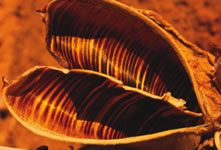
|

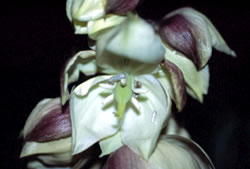
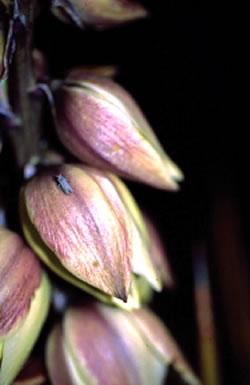
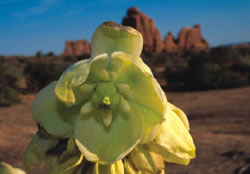
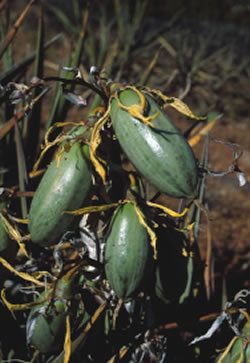
|






